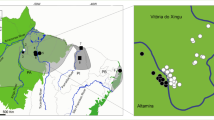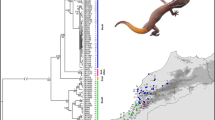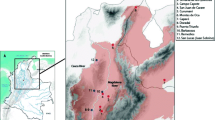Abstract
We used the results of phylogenetic analyses of relationships among spider monkeys (Ateles) based on mitochondrial and nuclear DNA to investigate questions of their evolutionary origins and speciation mechanisms. We employed the concept of a local molecular clock to date nodes of interest (corresponding to hypothesized species and subspecies) in the various phylograms for comparison to hypothesized biogeographical events that might have affected speciation. We considered various mechanisms—Pleistocene refuge formation, riverine barriers, geological fluctuations, and ecological changes associated with these mechanisms—for their contribution to speciation in Ateles. Most speciation among the various species of Ateles occurred during the middle to late Pliocene, suggesting that Pleistocene refuge formation was not a key speciation mechanism. However, it is likely that the genetic structure of populations of Ateles was modified to some extent by refuge formation. Additionally, riverine barriers do not seem to interrupt gene flow significantly among Ateles. No river formed a barrier among species of Ateles, with the exception of the lower Amazon and possibly some of the black-water rivers draining the Guianan highlands. Large-scale geographic changes associated with the continued rise of the eastern and western cordilleras of the northern Andes and associated changes in habitat were the most important causes of speciation in Ateles. The various factors that modify genetic structure in Ateles are important to consider in order to protect endangered primate genera in the Neotropics.
Similar content being viewed by others
REFERENCES
Aquino, R., and Encarnacion, F. (1994). Primates of Peru. Primate Rep. 40: 1-127.
Ayers, J. M., and Clutton-Brock, T. H. (1992). River boundaries and species range size in Amazonian primates. Am. Nat. 140: 537-551.
Bailey, W. J., Fitch, D. H., Tagle, D. A., Czelusniak, J., Slightom, J. L., and Goodman, M. (1991). Molecular evolution of the psi, nu-globin gene locus: gibbon phylogeny and the hominoid slowdown. Mol. Biol. Evol. 8: 155-184.
Bailey, W. J., Hayasaka, K., Skinner, C. G., Kehoe, S., Sieu, L. C., Slightom, J. L., and Goodman, M. (1992). Reexamination of the African hominoid trichotomy with additional sequences from the primate B-globin gene cluster. Mol. Phylogenet. Evol. 1: 97-135.
Brown, K. S. (1987). Conclusions, synthesis, and alternative hypotheses. In Whitmore, T. C., and Prance, G. T. (eds.), Biogeography and Quaternary History in Tropical America, Clarendon Press, Oxford, pp. 175-210.
Brown, K. S., and Prance, G. T. (1987). Soils and vegetation. In Whitmore, T. C., and Prance, G. T. (eds), Biogeography and Quaternary History in Tropical America. Clarendon Press, Oxford, pp. 175-210.
Bush, M. B. (1994). Amazonian speciation: A necessarily complex model. J. Biogeogr. 21: 5-17.
Coates, A. G., and Obando, J. A. (1996). The geologic evolution of the Central American isthmus. In Jackson, J. B. C., Budd, A. F., and Coates, A. G. (eds.), Evolution and Environment in Tropical America, University of Chicago Press, Chicago, pp. 21-56.
Colinvaux, P. A. (1996). Quartenary environmental history and forest diversity in the Neotropics. In Jackson, J. B. C., Budd, A. F., and Coates, A. G. (eds.), Evolution and Environment in Tropical America, University of Chicago Press, Chicago, pp. 359-406.
Collins, A. C. (1999). Species status of the Colombian spider monkey Ateles belzebuth hybridus. Neotrop. Primates Newsl. 7(2): 39-41.
Collins, A. C., and Dubach, J. M. (2000). Phylogenetic relationships among spider monkeys (Ateles) based on mitochondrial DNA variation. Int. J. Primatol. 21: 381-420.
Collins, A. C., and Dubach, J. M. (n.d.) Nuclear DNA variation among spider monkeys (Ateles). In preparation.
Cracraft, J. (1988). Deep-history biogeography: Retrieving the historical pattern of evolving continental biotas. Syst. Zool. 37: 221-236.
Croizat, L., Nelson, G., and Rosen, D. E. (1974). Centers of origin and related concepts. Syst. Zool. 23: 265-287.
daSilva, J. M. C., and Oren, D. C. (1996). Application of parsimony analysis of endemicity in Amazonian biogeography: An example with primates. Biol. J. Linn. Soc. 59: 427-437.
daSilva, M. N. F., and Patton, J. L. (1998). Molecular phylogeography and the evolution and conservation of Amazonian mammals. Mol. Ecol. 7: 475-486.
deBoer, L. E. M., and deBruijn, M. (1990). Chromosomal distinction between the red-faced and black-faced black spider monkeys (Ateles paniscus paniscus and A.p.chamek). Zoo Biol. 9: 307-316.
Endler, J. A. (1982). Pleistocene forest refuges: Fact or fancy? In Prance, G. T. (ed.), Biological Diversification in the Tropics, Columbia University Press, New York, pp. 641-656.
Engel, S. R., Hogan, K. M., Taylor, J. F., and Davis, S. K. (1998). Molecular systematics and paleobiogeography of the South American sigmodontine rodents. Mol. Biol. Evol. 15: 35-49.
Estrada, A., and Coates-Estrada, R. (1988). Tropical rain forest conversion and perspectives in the conservation of wild primates (Alouatta and Ateles) in Mexico. Am. J. Primatol. 14: 315-327.
Fedigan, L. M., Fedigan, L., Chapman, C., and Glander, K. E. (1988). Spider monkey home ranges: A comparison of radio telemetry and direct observation. Am. J. Primatol. 16: 19-29.
Ferrari, S. F., and Lopes, M. A. (1996). Primate populations in eastern Amazonia. In Norconck, M. A., Rosenberger, A. L., and Garber, P. A. (eds.), Adaptive Radiations of Neotropical Primates, Plenum Press, New York, pp. 53-55.
Froehlich, J. W., Supriantna, J., and Froehlich, P. H. (1991). Morphometric analyses of Ateles: Systematic and biogeographic implications. Am. J. Primatol. 25: 1-22.
Groves, C. P. (1989). A Theory of Human and Primate Evolution, Clarendon Press, Oxford, pp. 127-131.
Haffer, J. (1982). General aspects of the refuge theory. In Prance, G. T. (ed.), Biological Diversification in the Tropics, Columbia University Press, New York, pp. 5-22.
Haffer, J. (1987). Quartenary history of tropical America. In Whitmore, T. C., and Prance, G. T. (eds.), Biogeography and Quaternary History in Tropical America, Clarendon Press, Oxford, pp. 1-18.
Haffer, J. (1997). Alternative models of vertebrate speciation in Amazonia: An overview. Biodiver. Conserv. 6: 451-476.
Hernandez-Camacho, J., and Cooper, R. W. (1976). The nonhuman primates of Colombia. In Thorington, R. W., and Heltne, P. G. (eds.), Neotropical Primates: Field Studies and Conservation, National Academy of Sciences, Washington D.C., pp. 35-69.
Kellogg, R., and Goldman, E. A. (1944). Review on the Spider Monkeys. Proc. U. S. Mus. Nat. Hist. 96: 1-45.
Kimbel, W. H., and Martin, L. B. (1993). Species and speciation: Conceptual issues and their relevance for primate evolutionary biology. In Kimbel, W. H., and Martin, L. B. (eds.), Species, Species Concepts, and Primate Evolution, Plenum Press, New York.
Kimura, M. (1980). A simple model for estimating evolutionary rates of base substitutions through comparative studies of nucleotide sequences, J. Mol. Evol. 16: 111-120.
Kinzey, W. G. (1997). New World Primates: Ecology, Evolution and Behavior, Aldine de Gruyter, New York, pp. 192-199.
Konstant, W., Mittermeier, R. A., and Nash, S. D. (1985). Spider monkeys in captivity and in the wild. Primate Conserv. 5: 82-109.
Kunkel, L. M., Heltne, P. G., and Borgaonkar, D. S. (1980). Chromosomal variation and zoogeography in Ateles. Int. J. Primatol. 1: 223-232.
Madden, R. H., and Albuja, L. (1987). Conservation status of Ateles fusciceps fusciceps in northwestern Ecuador. Int. J. Primatol. 8: 513.
Medeiros, M. A., Barroso, R. M. S., Pieczarka, J. C., Nagamachi, C. Y., Ponsa, M., Garcia, M., Garcia, F., and Egozcue, J. (1997). Radiation and speciation of spider monkeys, genus Ateles from the cytogenetic viewpoint. Am. J. Primatol. 42: 167-178.
Milton, K. (1981). Estimates of reproductive parameters for free-ranging Ateles geoffroyi. Primates 22: 574-579.
Mittermeier, R. A., Kinzey, W. G., and Mast, R. B. (1989). Neotropical primate conservation. J. Hum. Evol. 18: 597-610.
Moore, J. (1993). Inbreeding and outbreeding in primates: What's wrong with ''the dispersing sex''? In Moore, J. (ed.), The Natural History of Inbreeding and Outbreeding, University of Chicago Press, Chicago.
Morain, S. A. (1984). Systematic and Regional Biogeography, Van Nostrand Reinhold, New York, pp. 177-199.
Norconck, M. A., Sussman, R. W., and Phillips-Conroy, J. P. (1996). Primates of Guyana shield forests. In Norconck, M. A., Rosenberger, A. L., and Garber, P. A. (eds.), Adaptive Radiations of Neotropical Primates, Plenum Press, New York, pp. 69-83.
Nunes, A. (1995). Status, distribution and viability of wild populations of Ateles belzebuth marginatus. Neotrop. Primates 3: 17-18.
Patton, J. L., and Smith, M. F. (1992). mtDNA phylogeny of Andean mice: A test of diversification across ecological gradients. Evolution 46: 174-183.
Patton, J. L., daSilva, M. N. F., and Malcolm, J. R. (1994). Gene genealogy and differentiation among arboreal spiny rats (Rodentia: Echimyidae) of the Amazon Basin: A test of the riverine barrier hypothesis. Evolution 48: 1314-1323.
Peres, C. A., Patton, J. L., and daSilva, M. N. F. (1996). Riverine barriers and gene flow in Amazonian saddle-back tamarins. Folia Primatol. 67: 113-124.
Pieczarka, J., Nagamachi, C. Y., and Barroso, R. M. S. (1989). The karyotype of Ateles paniscus paniscus (Cebidae, Primates): 2n = 32. Rev. Bras. Genet. 12: 543-551.
Porter, C. A., Page, S. L., Czelusniak, J., Schneider, H., Schneider, M. P., Sampaio, I., and Goodman, M. (1997). Phylogeny and evolution of selected primates as determined by sequences of the e-globin locus and 5' flanking regions. Int. J. Primatol. 18: 261-295.
Prance, G. T. (1987). Biogeography of Neotropical plants. In Whitmore, T. C., and Prance, G. T. (eds.), Biogeography and Quaternary History in Tropical America, Clarendon Press, Oxford, pp. 46-65.
Riddle, B. R. (1996). The molecular phylogeographic bridge between deep and shallow history in continental biotas. Trends Ecol. Evol. 11: 207-212.
Rossan, P. N., and Baerg, D. C. (1977). Laboratory and feral hybridization of Ateles geoffroyi panamensis Kellogg and Goldman, 1944, in Panama. Primates 18: 235-237.
Rowe, N. (1996). The Pictorial Guide to the Living Primates, Pogonias Press, East Hampton, New York, pp. 107-117.
Rylands, A. B., Mittermeier, R. A., and Rodriguez-Luna, E. (1997). Conservation of Neotropical primates: Threatened species and an analysis of primate diversity by country and region. Folia Primatol. 68: 134-160.
Sampaio, M. I., Schneider, M. P. C., and Schneider, H. (1993). Contribution of genetic distances studies to the taxonomy of Ateles, particularly Ateles paniscus paniscus and Ateles paniscus chamek. Int. J. Primatol. 14: 895-903.
Schneider, H., Schneider, M. P. C., Sampaio, I., Harada, M. L., Stanhope, M., Czelusniak, J., and Goodman, M. (1993). Molecular phylogeny of the New World Monkeys. Mol. Phylogenet. Evol. 2: 225-242.
Simpson, B. G., and Haffer, J. (1978). Speciation patterns in the Amazonian forest biota. Annu. Rev. Ecol. Syst. 9: 497-518.
Smith, M. F., and Patton, J. L. (1993). The diversification of South American murid rodents: Evidence from mitochondrial DNA sequence data for the Akodontine Tribe. Biol. J. Linn. Soc. 50: 149-177.
Symington, M. M. (1987). Sex ratio and maternal rank in wild spider monkeys: When daughters disperse. Behav. Ecol. Sociobiol. 20: 421-425.
Symington, M. M. (1988). Demography, ranging patterns, and activity budgets of black spider monkeys (Ateles paniscus chamek) in the Manu National Park, Peru. Am. J. Primatol. 15: 45-67.
Symington, M. M. (1990). Fission-fusion social organization in Ateles and Pan. Int. J. Primatol. 11: 47-61.
Terborgh, J., and Winter, B. (1982). Evolutionary circumstances of species with small ranges. In Prance, G. T. (ed.), Biological Diversification in the Tropics, Columbia University Press, New York, pp. 587-600.
van der Hammen, T. (1982). Paleoecology of Tropical South America. In Prance, G. T. (ed.), Biological Diversification in the Tropics, Columbia University Press, New York, pp. 60-65.
van Roosmalen, M. G. M. (1980). Habitat preferences, diet, feeding strategy, and social organization of the black spider monkey (Ateles paniscus paniscus) in Surinam, Ph.D. Thesis, University of Wageningen, Netherlands.
White, B. N. (1986). The isthmian link, antitropicality and American biogeography: Distributional history of the Atherinopsinae (Pisces: Atherinidae). Syst. Zool. 35: 176-194.
Wolfheim, J. H. (1983). Primates of the World: Distribution, Abundance, and Conservation, University of Washington Press, Seattle, pp. 246-256.
Author information
Authors and Affiliations
Rights and permissions
About this article
Cite this article
Collins, A.C., Dubach, J.M. Biogeographic and Ecological Forces Responsible for Speciation in Ateles. International Journal of Primatology 21, 421–444 (2000). https://doi.org/10.1023/A:1005487802312
Issue Date:
DOI: https://doi.org/10.1023/A:1005487802312




